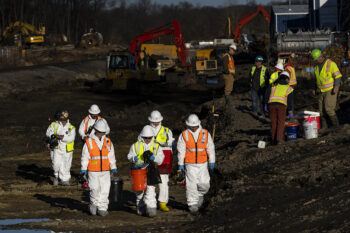Public Health Professor Receives Federal Funding For Air Quality Assessment In East Palestine

Dr. Natalie Johnson, an associate professor of environmental health in the Texas A&M University School of Public Health, has been awarded funding from the National Institute of Environmental Health Sciences (NIEHS) to research air pollution and associated health risks resulting from the train derailment environmental disaster in East Palestine, Ohio.
Her efforts were among those called “heroic” by President Biden during his recent visit to the site.
Johnson, whose expertise is evaluation of adverse health effects from exposure to air pollutants, directs the Texas A&M University Mobile Responding to Air Pollution in Disasters (mRAPIDvan), a unique mobile platform that allows for real-time detection of chemical air pollutants. She will lead a team of researchers using mRAPIDvan in evaluating the distribution of volatile organic compound (VOC).
“Last year our team conducted outdoor air sampling in East Palestine mid-February through April,” Johnson said. “We are excited to compare the outdoor levels of VOCs currently present in East Palestine, over a year after the disaster.”
The research team will determine the distribution and potential hazard of VOCs previously measured in East Palestine in spring of 2023 and compare those with the findings of additional mobile air monitoring at 12, 13 and 14 months after the disaster. Health hazards will be assessed using existing computational toxicology research databases and, most importantly, findings will be reported back to residents in collaboration with other NIEHS-funded researchers and local community organizations.
“Since we have data at the neighborhood level from driving the mRAPIDvan, we have the opportunity to evaluate potential hazard from these pollutants and linkage with reported health effects,” Johnson said.
Joining Johnson on the research team is Dr. Weihsueh Chiu, a professor at the Texas A&M School of Veterinary Medicine and Biomedical Sciences and co-director of the Texas A&M Superfund Research Center. Their research in East Palestine after the derailment was part of the Texas A&M Superfund Research Center and initial sampling was made possible due to Texas A&M University institutional commitment. The team will also continue to collaborate with Dr. Albert Presto at Carnegie Mellon University’s Center for Atmospheric Particle Studies.
Media contact: Rae Lynn Mitchell, raemitchell@tamu.edu





